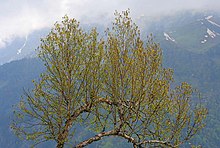| Betula utilis | |
|---|---|

| |
| Scientific classification | |
| Kingdom: | Plantae |
| Clade: | Tracheophytes |
| Clade: | Angiosperms |
| Clade: | Eudicots |
| Clade: | Rosids |
| Order: | Fagales |
| Family: | Betulaceae |
| Genus: | Betula |
| Subgenus: | Betula subg. Neurobetula |
| Species: | B. utilis
|
| Binomial name | |
| Betula utilis | |
| Synonyms | |
|
B. bhojpatra Wall. | |
Betula utilis, the Himalayan birch (bhojpatra, Sanskrit: भूर्ज bhūrjá), is a deciduous tree native to the Western Himalayas, growing at elevations up to 4,500 m (14,800 ft). The Latin specific epithet utilis means "useful", and refers to the many uses of the different parts of the tree.[2] The white, paper-like bark was used in ancient times as a writing surface for manuscripts of Sanskrit literature.[3] It is still used as paper for the writing of mantras, with the bark placed in an amulet and worn for protection.[4] Selected varieties are used for landscaping throughout the world, even while some areas of its native habitat are being lost due to overuse of the tree for firewood.
- ^ Shaw, K., Roy, S. & Wilson (2014). "Betula utilis. The IUCN Red List of Threatened Species". IUCN Red List. doi:10.2305/IUCN.UK.2014-3.RLTS.T194535A2346136.en. Retrieved 2022-08-05.
{{cite journal}}: CS1 maint: multiple names: authors list (link) - ^ Liu, Cuirong; Elvin, Mark (1998). Sediments of time: environment and society in Chinese history. Cambridge, UK: Cambridge University Press. p. 65. ISBN 0-521-56381-X.
- ^ Cite error: The named reference
Müllerwas invoked but never defined (see the help page). - ^ Cite error: The named reference
Wheelerwas invoked but never defined (see the help page).
